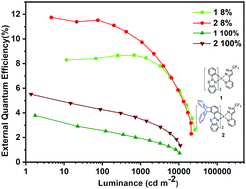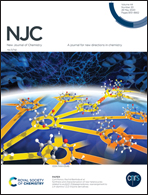Effect of the triptycene scaffold on the photophysical, electrochemical and electroluminescence properties of the iridium(iii) complex†
Abstract
A new iridium(III) complex Ir(tbt)2(fppz) (2) (fppzH = 2-(3-trifluoromethyl-1H-pyrazol-5-yl)-pyridine) with a triptycenylbenzothiazole (tbt) ligand and its parent complex Ir(bt)2(fppz) (1) with a phenylbenzothiazole (bt) ligand have been synthesized and characterized. The decomposition temperature (Td(5%)) of complex 2 is 395 °C, which is 16 °C higher than that of parent complex 1. Complex 2 showed an emission peak at 546 nm with a PLQY of 67.8%. When compared with complex 1, its luminescent wavelength red-shifted by 11 nm, the PLQY increased by 13% and the luminescent lifetime shortened by 20%. Moreover, the luminescence quenching of complex 2 at a high concentration (30 wt% in PMMA) is found to be effectively prevented, and the PLQY of complex 2 is three times more than that of complex 1. The electron-donating nature of the triptycene scaffold pushes up the HOMO level of complex 2. As a result, complex 2 achieves a higher non-doped device performance, revealing a maximum current efficiency/EQE of 12.6 cd A−1/5.5%, which are obviously higher than that of complex 1 (9.8 cd A−1, 3.8%). The doped device of complex 2 shows a maximum current efficiency/EQE of 29.8 cd A−1/11.8%. These findings suggest that the comprehensive performance of iridium(III) complexes can be obviously improved by the careful introduction of a triptycene scaffold.



 Please wait while we load your content...
Please wait while we load your content...